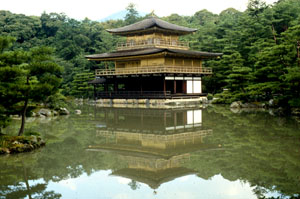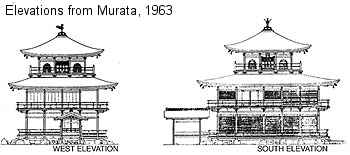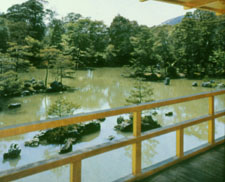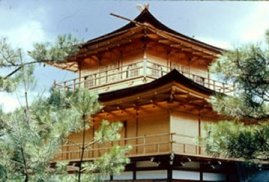Kinkaku-ji |
|
Originally built by Ashikaga Yoshimitsu in 1338, the Kinkaku-ji, or Golden Pavilion, is a fine example of the architecture of the Muromachi period. It is here that Yoshimitsu planned to spend his retirement and to become a monk, so no expenses were barred. The land for the villa and eventually the temple is located in the Kitayama, or literally Northern Mountain, region of the capital city of Kyoto. Before it became part of a large temple complex, the first floor was Yoshimitsu’s living quarters. The plan of the first floor, called the Hosuiin, or Chamber of Dharma Waters was designed in the Shinden Zukuri style, or the domestic style of architecture of that time. Rectangular doors and screens open up to frame various views of the garden and pond landscape. The front of the pavilion faces north towards the pond, while along the eastern wall, a small platform, called the Tsuridono, protrudes into the pond. It is believed that originally the pavilion was set on an island in the middle of the pond and the only way to access the pavilion was to row out to that platform. The second floor, called the Chuonkaku, or Tower of the Sound of Waves, was designed in the Japanese residential style of architecture and consisted of a veranda that ran around the outside of the exterior. It takes up the same amount of space as the first floor, however, it has its own roof system and the exterior was leafed in gold. It contained the image of the Buddha on a small alcove along the northern wall of the room.
Ginkaku-ji
|

 The third floor, called
the Kukyocho, or Cupola of the Ultimate, was designed in the Zen style
of architecture. Originally, the smaller third floor contained what is
believed to have been some of the bones and teeth of Buddha. Later it
simply held an image of the Amida triad and several Bodhisattvas. It
also has a veranda that goes all the way around the exterior, however,
it is interrupted by the staircase that comes up from the second
floor.
The third floor, called
the Kukyocho, or Cupola of the Ultimate, was designed in the Zen style
of architecture. Originally, the smaller third floor contained what is
believed to have been some of the bones and teeth of Buddha. Later it
simply held an image of the Amida triad and several Bodhisattvas. It
also has a veranda that goes all the way around the exterior, however,
it is interrupted by the staircase that comes up from the second
floor.
